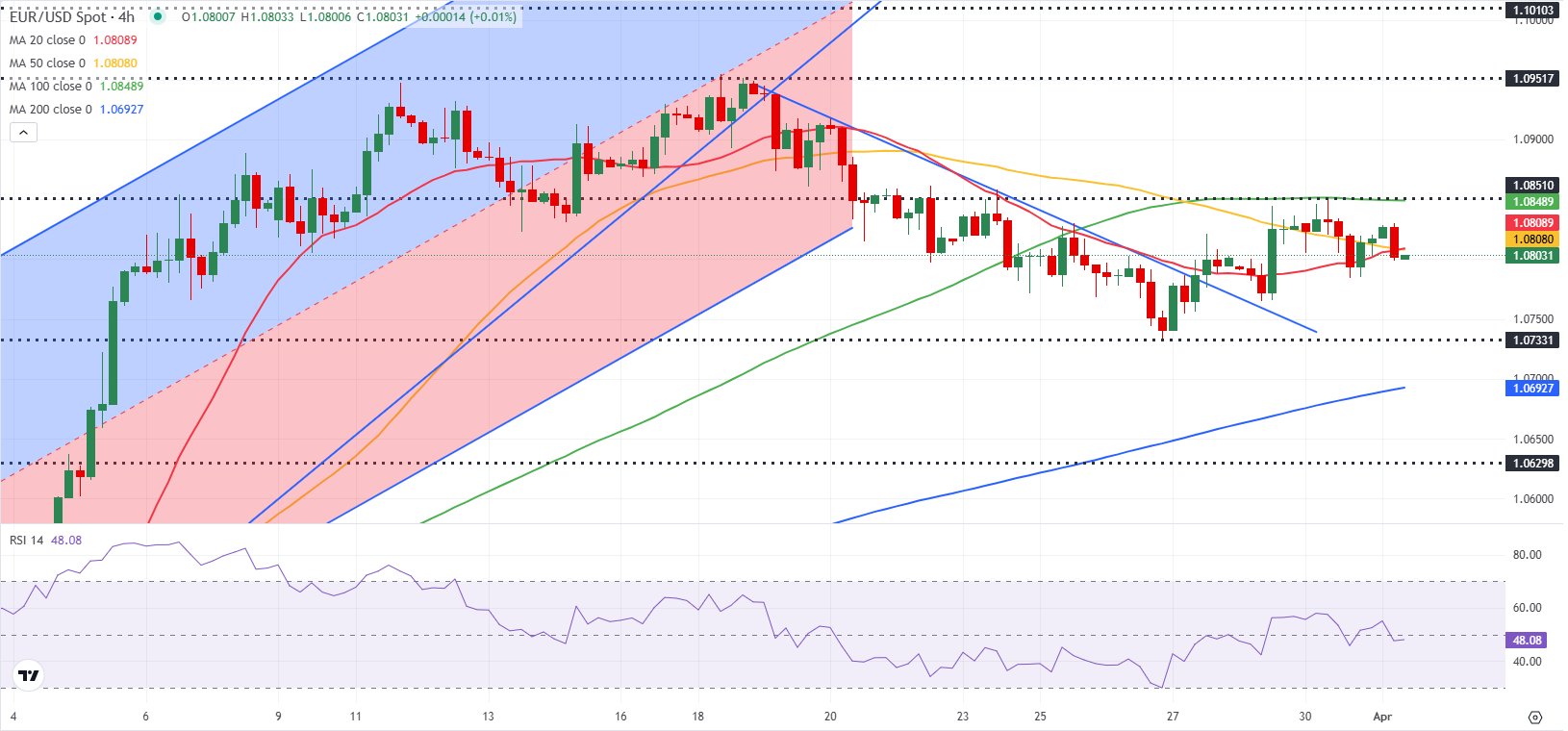- EUR/USD trades near 1.0800 after posting small losses on Monday.
- Investors refrain from taking large positions ahead of US tariff announcements.
- The US economic calendar will feature JOLTS Job Openings and ISM Manufacturing PMI data.
After rising to a fresh weekly high near 1.0850 on Monday, EUR/USD lost its traction and closed the day marginally lower. The pair struggles to hold its ground and trades near 1.0800 in the European session on Tuesday as markets remain risk-averse ahead of Wednesday's tariff announcements from the US.
Euro PRICE This week
The table below shows the percentage change of Euro (EUR) against listed major currencies this week. Euro was the weakest against the Japanese Yen.
| USD | EUR | GBP | JPY | CAD | AUD | NZD | CHF | |
|---|---|---|---|---|---|---|---|---|
| USD | 0.24% | 0.22% | -0.15% | 0.64% | 0.60% | 0.79% | 0.36% | |
| EUR | -0.24% | 0.07% | -0.37% | 0.43% | 0.44% | 0.58% | 0.16% | |
| GBP | -0.22% | -0.07% | -0.44% | 0.40% | 0.36% | 0.53% | 0.12% | |
| JPY | 0.15% | 0.37% | 0.44% | 0.79% | 0.80% | 0.98% | 0.43% | |
| CAD | -0.64% | -0.43% | -0.40% | -0.79% | 0.00% | 0.15% | -0.27% | |
| AUD | -0.60% | -0.44% | -0.36% | -0.80% | -0.00% | 0.15% | -0.27% | |
| NZD | -0.79% | -0.58% | -0.53% | -0.98% | -0.15% | -0.15% | -0.43% | |
| CHF | -0.36% | -0.16% | -0.12% | -0.43% | 0.27% | 0.27% | 0.43% |
The heat map shows percentage changes of major currencies against each other. The base currency is picked from the left column, while the quote currency is picked from the top row. For example, if you pick the Euro from the left column and move along the horizontal line to the US Dollar, the percentage change displayed in the box will represent EUR (base)/USD (quote).
Following a bearish opening, Wall Street's main indexes recovered sharply on Monday, limiting the US Dollar's (USD) gains and helping EUR/USD find support. Early Tuesday, however, US stock index futures trade in negative territory.
In the second half of the day, February JOLTS Job Openings and March ISM Manufacturing Purchasing Managers Index (PMI) data will be featured in the US economic docket.
Federal Reserve (Fed) Bank of Richmond President Thomas Barkin said on Monday that he is nervous about inflation and employment. Hence, a significant decline in the job openings could hurt the USD with the immediate reaction. Meanwhile, the ISM Manufacturing PMI is expected to drop into the contraction territory below 50. In case this data comes in above 50, it could support the USD.
Nevertheless, the market reaction is likely to remain short-lived, with investors refraining from taking large positions before seeing the details of the US tariff decisions and assessing their potential impact on the economic outlook.
EUR/USD Technical Analysis

The Relative Strength Index (RSI) indicator on the 4-hour chart retreated below 50 and EUR/USD closed below the 20-day Simple Moving Average (SMA) after testing this level on Monday, reflecting buyers' hesitancy.
In case 1.0800 (round level, static level) fails, technical sellers could take action and open the door for an extended slide toward 1.0730 (200-day SMA). On the upside, 1.0840 (20-day SMA) aligns as first resistance before 1.0900 (static level, round level) and 1.0950 (static level).
Euro FAQs
The Euro is the currency for the 19 European Union countries that belong to the Eurozone. It is the second most heavily traded currency in the world behind the US Dollar. In 2022, it accounted for 31% of all foreign exchange transactions, with an average daily turnover of over $2.2 trillion a day. EUR/USD is the most heavily traded currency pair in the world, accounting for an estimated 30% off all transactions, followed by EUR/JPY (4%), EUR/GBP (3%) and EUR/AUD (2%).
The European Central Bank (ECB) in Frankfurt, Germany, is the reserve bank for the Eurozone. The ECB sets interest rates and manages monetary policy. The ECB’s primary mandate is to maintain price stability, which means either controlling inflation or stimulating growth. Its primary tool is the raising or lowering of interest rates. Relatively high interest rates – or the expectation of higher rates – will usually benefit the Euro and vice versa. The ECB Governing Council makes monetary policy decisions at meetings held eight times a year. Decisions are made by heads of the Eurozone national banks and six permanent members, including the President of the ECB, Christine Lagarde.
Eurozone inflation data, measured by the Harmonized Index of Consumer Prices (HICP), is an important econometric for the Euro. If inflation rises more than expected, especially if above the ECB’s 2% target, it obliges the ECB to raise interest rates to bring it back under control. Relatively high interest rates compared to its counterparts will usually benefit the Euro, as it makes the region more attractive as a place for global investors to park their money.
Data releases gauge the health of the economy and can impact on the Euro. Indicators such as GDP, Manufacturing and Services PMIs, employment, and consumer sentiment surveys can all influence the direction of the single currency. A strong economy is good for the Euro. Not only does it attract more foreign investment but it may encourage the ECB to put up interest rates, which will directly strengthen the Euro. Otherwise, if economic data is weak, the Euro is likely to fall. Economic data for the four largest economies in the euro area (Germany, France, Italy and Spain) are especially significant, as they account for 75% of the Eurozone’s economy.
Another significant data release for the Euro is the Trade Balance. This indicator measures the difference between what a country earns from its exports and what it spends on imports over a given period. If a country produces highly sought after exports then its currency will gain in value purely from the extra demand created from foreign buyers seeking to purchase these goods. Therefore, a positive net Trade Balance strengthens a currency and vice versa for a negative balance.
Information on these pages contains forward-looking statements that involve risks and uncertainties. Markets and instruments profiled on this page are for informational purposes only and should not in any way come across as a recommendation to buy or sell in these assets. You should do your own thorough research before making any investment decisions. FXStreet does not in any way guarantee that this information is free from mistakes, errors, or material misstatements. It also does not guarantee that this information is of a timely nature. Investing in Open Markets involves a great deal of risk, including the loss of all or a portion of your investment, as well as emotional distress. All risks, losses and costs associated with investing, including total loss of principal, are your responsibility. The views and opinions expressed in this article are those of the authors and do not necessarily reflect the official policy or position of FXStreet nor its advertisers. The author will not be held responsible for information that is found at the end of links posted on this page.
If not otherwise explicitly mentioned in the body of the article, at the time of writing, the author has no position in any stock mentioned in this article and no business relationship with any company mentioned. The author has not received compensation for writing this article, other than from FXStreet.
FXStreet and the author do not provide personalized recommendations. The author makes no representations as to the accuracy, completeness, or suitability of this information. FXStreet and the author will not be liable for any errors, omissions or any losses, injuries or damages arising from this information and its display or use. Errors and omissions excepted.
The author and FXStreet are not registered investment advisors and nothing in this article is intended to be investment advice.
Recommended Content
Editors’ Picks

AUD/USD: Extra gains need to clear 0.6400
AUD/USD rose for the third day in a row, approaching the key 0.6400 resistance on the back of the acute pullback in the US Dollar amid mounting recession concerns and global trade war fear.

EUR/USD: Powell and the NFP will put the rally to the test
EUR/USD gathered extra steam and advanced to multi-month peaks near 1.1150, although the move fizzled out somewhat as the NA session drew to a close on Thursday.

Gold holds positive ground above $3,100, all eyes on US NFP data
Gold price recovers some lost ground to near $3,115 during the late American session on Thursday after facing some profit-taking in the previous session. Escalating concerns over a global trade war and ongoing geopolitical risks boost the Gold price, a traditional safe-haven asset.

Ethereum: Short-term holders may not impact ETH's price, Pectra mainnet upgrade set for May 7
Ethereum declined by 3% on Thursday as market participants continued to react to President Donald Trump's announcements regarding reciprocal tariffs. However, the selling pressure may not persist since most ETH short-term holders already sold their assets in March.

Trump’s “Liberation Day” tariffs on the way
United States (US) President Donald Trump’s self-styled “Liberation Day” has finally arrived. After four straight failures to kick off Donald Trump’s “day one” tariffs that were supposed to be implemented when President Trump assumed office 72 days ago, Trump’s team is slated to finally unveil a sweeping, lopsided package of “reciprocal” tariffs.

The Best brokers to trade EUR/USD
SPONSORED Discover the top brokers for trading EUR/USD in 2025. Our list features brokers with competitive spreads, fast execution, and powerful platforms. Whether you're a beginner or an expert, find the right partner to navigate the dynamic Forex market.